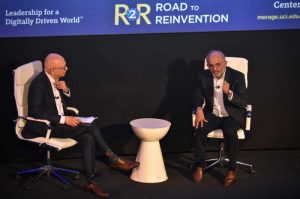Open Data Initiative to Empower Companies and Revolutionize Customer Experience, Says Shantanu Narayen, CEO of Adobe by CDT

Too often, companies’ internal and external data exists in silos, making it impossible for them to take advantage of that data and gain a holistic view of customer interactions and operations.
But what if there was a way to move all that data to the cloud so that companies could apply data science, draw conclusions and implement solutions to better serve the needs of their customers?
That’s exactly the premise behind the Open Data Initiative, an ambitious effort from technology pioneers Adobe, Microsoft and SAP.
“The initiative will standardize data formats and create a new method of publishing by integrating the Adobe Experience Platform with Microsoft Dynamics 365,” Shantanu Narayen, CEO of Adobe, said at the Center for Digital Transformation’s Road to Reinvention conference in March.
The Open Data Initiative is predicated on the idea that companies need to be open, and recognize that the data is owned by the customers. Adobe acknowledged this idea in 2009, as the company embarked on its own digital transformation.
“We realized that we weren’t attracting new customers to the platform, and the cost of the software was an impediment,” Narayen said. “But perhaps most fundamental, we realized that we weren’t innovating at a fast enough pace.”
Therefore, Adobe moved from a 12-18 month product cycle to a continuous time cycle (and from perpetual revenue to recurring revenue), which required customer interaction and insight to be successful.
In addition, the company recognized that it wasn’t mission critical to the business of publishing. By creating a full stack of digital marketing enterprise software, the company was able to target chief revenue, digital and marketing officers for the first time.
Adobe also purchased a web analytics company, Omniture, so that the company would no longer have to wonder what type of customers they served, or what type of services their customers desired.
“We’ve become comfortable with the belief that if you can connect all the dots from where you are today to where you want to go, you’re probably not being aspirational enough,” Narayen said. “But how do you harness the ingenuity of the tens of thousands of employees that you have?”
“You plant this flag, and the truth is, you don’t know how to get there, but amazing individuals will help you figure that out.”
Too often, companies’ internal and external data exists in silos, making it impossible for them to take advantage of that data and gain a holistic view of customer interactions and operations. But what if there was a way to move all that data to the cloud so that companies could apply data science, draw conclusions and implement solutions to better serve the needs of their customers? That’s exactly the premise behind the Open Data Initiative, an ambitious effort from technology pioneers Adobe, Microsoft and SAP. “The initiative will standardize data formats and create a new method of publishing by integrating the Adobe Experience Platform with Microsoft Dynamics 365,” Shantanu Narayen, CEO of Adobe, said at the Center for Digital Transformation’s Road to Reinvention conference in March. The Open Data Initiative is predicated on the idea that companies need to be open, and recognize that the data is owned by the customers. Adobe acknowledged this idea in 2009, as the company embarked on its own digital transformation. “We realized that we weren’t attracting new customers to the platform, and the cost of the software was an impediment,” Narayen said. “But perhaps most fundamental, we realized that we weren’t innovating at a fast enough pace.” Therefore, Adobe moved from a 12-18 month product cycle to a continuous time cycle (and from perpetual revenue to recurring revenue), which required customer interaction and insight to be successful. In addition, the company recognized that it wasn’t mission critical to the business of publishing. By creating a full stack of digital marketing enterprise software, the company was able to target chief revenue, digital and marketing officers for the first time. Adobe also purchased a web analytics company, Omniture, so that the company would no longer have to wonder what type of customers they served, or what type of services their customers desired. “We’ve become comfortable with the belief that if you can connect all the dots from where you are today to where you want to go, you’re probably not being aspirational enough,” Narayen said. “But how do you harness the ingenuity of the tens of thousands of employees that you have?” “You plant this flag, and the truth is, you don’t know how to get there, but amazing individuals will help you figure that out.”
